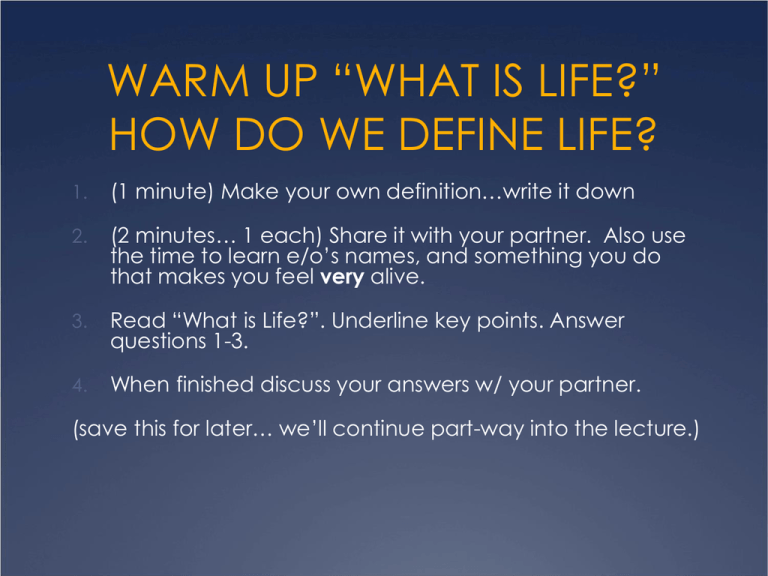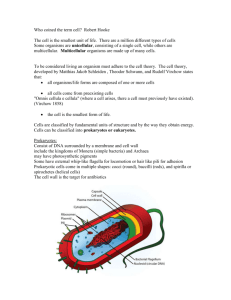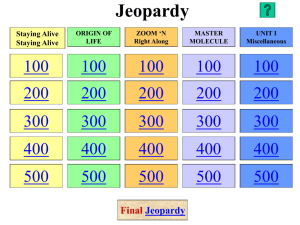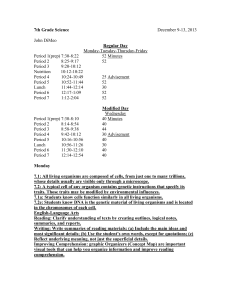CHAPTER 1
advertisement

WARM UP “WHAT IS LIFE?” HOW DO WE DEFINE LIFE? 1. (1 minute) Make your own definition…write it down 2. (2 minutes… 1 each) Share it with your partner. Also use the time to learn e/o’s names, and something you do that makes you feel very alive. 3. Read “What is Life?”. Underline key points. Answer questions 1-3. 4. When finished discuss your answers w/ your partner. (save this for later… we’ll continue part-way into the lecture.) CHAPTER 1 Ten Themes in the Study of Life Ten themes in Biology: 1. Emergent Properties 2. The Cell 3. Heritable Information 4. Structure-Function 5. Interaction with the Environment (interdependence/energy transfer) 6. Regulation 7. Unity and Diversity (continuity & change) 8. Evolution 9. Scientific Inquiry (science as a process) 10. Science, Technology, and Society WHY USE THEMES??? Large volume of vocabulary & facts. Themes help make connections. scales of size and time vary greatly. Themes apply to life on many levels- microscopic to whole systems. Themes are core principals that cut through the material… no matter what topic you are studying they can be applied = OVERARCHING CONCEPTS Paul Sereno, paleontologist Flossie Wong-Staal, HIV researcher Joanne Chory. Plant Biologist George Langford, Cell Biologist 4 BIG IDEAS combine themes 1. The process of evolution drives the diversity and unity of life. 2. Biological systems utilize free energy and molecular building blocks to grow, to reproduce, and to maintain dynamic homeostasis. 3. Living systems store, retrieve, transmit, and respond to information essential to life processes. 4. Biological systems interact and these systems and their interactions possess complex properties. 4 minute BRAINSTORM then discuss w/ your partner QUESTIONS TO CONSIDER: What do you think each idea means? Can you provide an example of each? Which characteristics of life apply to each big idea? 1) EMERGENT PROPERTIES REDUCTIONISM is a “top down” approach used to understand the nature of complex things by reducing them to 1. Simpler more fundamental parts. Or 2. the interactions of their parts. Looking at life “bottom up”, ORDER (a high degree of it) is a basic characteristic of life, at any level... Each level, ATOM to the BIOSPHERE, is organized. Properties result from interactions between the components. At each larger level unique properties “emerge” or appear. Ex. LIFE only exists at the level of CELL, which is made of organelles, etc.. HIERARCHY OF ORGANIZATION each level builds on the levels below it… can you put these in order small to big? Multicellular Organism Cell Atom Molecule Biosphere Organelle Chemical building block Biome Organ system Macromolecule Community Organ Population Tissue Ecosystem HIERARCHY OF ORGANIZATION smallest components of living things to the largest groupings of them. 1. atom 2. molecule 3. Chemical building block 4. Macromolecule 5. organelle 6. cell 7. Tissue 8. Organ 9. Organ system 10. Multicellular organism 11. population 12. community 13. ecosystem 14. biome 15. BIOSPHERE Bioverses??? THE TOTAL IS GREATER THAN THE SUM OF IT’S PARTS. Life is more than just the atoms, molecules, & cells that compose it… there are also properties/qualities/characteristics that “EMERGE” because of interactions. The phenomena of evolution occurs because of interactions of organisms and their environment through differential reproduction- only at the level of POPULATION. How do we define Life? A collection of characteristics. All PROPERTIES (characteristics) emerge at the final “level” of LIFE- the CELL (in the cells of these multicelled creatures) What characteristics/properties of life do you observe? SOME PROPERTIES OF LIFE How do we define Life? All PROPERTIES emerge at the final “level” of LIFE. Nonliving things may have some of these propertiesbut only living things have ALL of them. M R S C H O G E D Characteristics of living things Metabolism (chemical reactions that utilize matter & energy) Reproduction (by copying & transmitting DNA) Sensitivity (responds to stimulus) Cells (the basic unit of life) Homeostasis (maintains a steady state) Order & complexity (much more complex than nonliving things) Growth & development (based on DNA) Evolutionary Adaptation (changes that accumulate over generations) DNA (Deoxyribonucleic Acid- the molecule of heredity) Metabolism Energy Utilization (Adaptation) reproduction ORDER Growth and Development Basically, Life is defined by a collection of qualities or characteristics. MRS CHOGED WHAT IS LIFE? Activity/ Warm UP continued Pick 5 specimen to observe. For each specimen check off the characteristics it has. Analyze your findings 4-13. If the specimen is living it should have a check by all of them. If the specimen does not have checks for all it is either inanimate or dead Dead things still have: cells, DNA, order, & physical evolutionary adaptations. 2) Cells… basic unit of life THE CELL THEORY (schleiden, schwann, virchow) 1) All living things consist of cells. 2) Cells are an organism’s basic unit of structure and function. 3) All cells come from other cells. Hooke (1665) English, observed cork- dead plant material, 30x, “cells” Leeuwenhoek (Dutch), observed pond water, 300x, 1st living cells “animacules”, protists, sperm, blood (1839) Schleiden & Schwann- German, The cell is the universal unit of life. Virchow (1855) German, “Omnis cellula e cellula.”… “Every cell originates from another cell.” Cell Types: (there are two) 1) Prokaryotic cells - ex. bacteria & archaea 2) Eukaryotic cells - ex. all other life forms Similarities: both have DNA and are enclosed by a membrane. Differences: Eukaryotic cells are larger and have internal membranes which divide the cell into functional compartments called “organelles”- ex. The nucleus in the membrane around the DNA. 3) Heritable Information DNA (deoxyribonucleic acid) is the substance of genes- instructions to make protein and protein makes the creature what it is. Units of inheritance passed from parents to offspring. Double stranded molecule made of 4 chemical “letters” or nucleotides (ATGC). Human genome is 6 billion “letters” long in 23 pairs of chromosomes. The genetic material: DNA 4) Structure Relates to Function Form (structure) fits function (job) & vice versa. Ex. Nerve cells are shaped differently than skin cells- allows for rapid communication. Bird bones shaped to be lighter than those of reptiles or mammalsallows for flight. Form fits function Andreas Vesalius 1514-1564 was a Flemish anatomist and author of one of the most influential books on human anatomy,De humani corporis fabrica (On the Workings of the Human Body). Founder of modern human anatomy. There is an Anatomy & Physiology (H/R) class taught here at • You do not Pali. have to know this for the test FYIO 5) Interaction With Environment Organisms are open systems. Open systems exchange materials and energy with their surroundings. Ecosystems are composed of living organisms and their nonliving environment. Two main principles of Ecology: 1. Cycling/Recycling of nutrients from environment to organisms (back) to relies on producers & decomposers = biogeochemical cycles. ex. carbon 2. Flow of energy from sun to living organisms through food chains and back to space as heat from each link in the chain. ex. 10% rule The Nitrogen Cycle is one of the more complex biogeochemical cycles. An introduction to energy flow and energy transformation in an ecosystem 6)Regulation Enzymes are protein molecules that regulate chemical reactions in cells. These biological catalysts speed up reactions. Feedback loops self-regulate biological processes. A product of a process regulates that same process May stop or encourage the production of key enzymes. 2 types: 1.negative feedback (insulin/glucagon- blood sugar) A physiological control mechanism in which a change in a physiological variable triggers a response that counteracts the initial change. A primary mechanism of homeostasis. 2.positive feedback (oxytocin- uterine contractions) A physiological control mechanism in which a change in a variable triggers mechanisms that amplify the change. Regulate blood sugar levels w/ this pair of hormones. The production of each is controlled by negative feedback. After a meal… Insulin causes liver and muscle cells to take up excess glucose from your blood and attach them together to make large glycogen polymers. When blood sugar level is lowered your body stops making insulin. Between meals… Glucagon causes stored glucose to be released into your blood stream from glycogen. When you have enough glucose, your body stops making glucagon. Regulation by feedback mechanisms Positive feedback speeds a process up. Snowball effect. Examples: 1. Clotting of Blood- platelets release chemicals that attract more platelets… so more chemicals are released… so more platelets arrive… ENDS when scab forms- no more wound to attract platelets. 2. Baby pressure on uterine wall causes release of oxytocin, which causes uterine contractions which causes more pressure on uterine wall… and the production of more oxytocin… and so on ENDS when baby leaves uterus- no more pressure on uterus. 7) Unity and Diversity “Vertical” dimension is the size scale reaching from molecules to the bioshphere. “Horizontal” dimension stretches across the diversity of life now and throughout life’s history (3.5 billion years of history) includes extinct ancestors. 1.5 million extant (living) species identified so far. Estimated 5-40 Million species to exist. Biodiversity is the measure of the number of species and the abundance of each as well. species richness (zoo) vs. diversity (rainforest) A small sample of biological diversity TAXONOMY is the branch of biology that names and classifies species. (Aristotle vs. Linnaeus) Organisms are categorized into: Three DOMAINS of Life: 1. Bacteria- prokaryotes 2. Archaea- prokaryotes 3. Eukarya- eukaryotes Five or Six KINGDOMS of Life. 1. Animalia 2. Plantae 3. Fungi 4. Protista (prokaryotes) 5. Monera or 5. Archaea 6. Bacteria Three domains of life HOW DO YOU CLASSIFY LIFE FROM GENERAL TO SPECIFIC? Linnaeus’ nested heirarchy. Classifying life from most general to most specific Kingdom Phylum Class Order Family Genus Species Keep Pots Clean Or Family Gets Sick Kinky People Come Over For Group Sex King Phillip Came Over For Good Sex An example of unity underlying the diversity of life: the architecture of eukaryotic cilia Explain? 8)Evolution (core theme) Evolution is the core theme of biology. Process that accounts for the combination of unity and diversity in life. Implies that all living things are related. The common ancestors are prokaryotes that existed 3.5 billion years ago. TREE OF LIFE The organisms that are alive today are but the leaves of this giant tree if we could trace their history back down the branches of the Tree of Life we would encounter their ancestors,\ which lived thousands or millions or hundreds of millions of years ago Charles Darwin developed The concept of Natural Selection. Observations: a.) Individual variation. b.) Struggle for existence. Inference: Differential reproductive success. Charles Darwin (1809–1882) Diversification of finches on the Galápagos Islands Differential reproductive success was called NATURAL SELECTION by Darwin. Natural Selection does not CREATE adaptations, it screens variations that are heritable In the next generation we see a higher proportion of a trait. Evolutionary adaptation is a product of natural selection Weedy sea dragon Survival of the fittest- fitness is measured by reproductive success. Inspired by Malthus- said that populations grow faster than the resources to support them. Galapagos Islands- “new” land, off the west coast of South America. Finches, tortoises, iguanas. Careful observation and measurement provide the raw data for science 9) Scientific Inquiry… a search for information and explanation often focusing on specific questions. TWO MAIN FORMS OF INQUIRY: 1. Discovery Science describes natural structures and processes as accurately as possible through careful observation and analysis of data. Conclusions based on logic… “inductive reasoning”. Ex. microscope observations led to the CELL THEORY 2. Hypothesis-Based Science Process of inquiry that includes repeatable observations and testable hypotheses… “deductive reasoning” if… then statement. Science “to know” is limited to those structures and processes we can observe and measure. Science can not answer questions like “Why are we here?” … this is why the humanities are so important. Applying hypothetico-deductive reasoning to a campground problem If… then… reasoning Works backwards from The general to the specific. Flashlight doesn’t work If the bulb is the culprit Then it should work w/ a New bulb! THEORY Comprehensive explanation supported by abundant evidence. Idea that ties together observations and experimental results that previously seemed unrelated. Newton, Einstein, Darwin Gravity, Relativity, Natural Selection Two examples of DNA technology CNN bionic arm 10) Science, Technology & Society Goal oriented applications of science. Ex. End world hunger- GMO’s super crops. Ex. End reliance on burning fossil fuels- Nuclear Power Plants Sometimes present new problems. Ex. Farmer’s rights, food allergies, invasive species, loss of diversity. Ex. nuclear waste disposal, accidents… Research feeds technology and vice versa. Winter Reading: “The Immortal Life of Henrietta Lacks” Class Discussion: Biotechnology PROS vs. CONS HOMEWORK 1. Review your notes… answer the four outline questions. 2. Skip, Skim over, or read carefully: chapter 2 CHEMISTRY. 3. Mandatory Reading & Cornell Notes/Flash Cards- Chapter 3. 7 SCIENCE PRACTICES The student can… 1. Use representations and models to communicate scientific phenomena and solve scientific problems. 2. Use mathematics appropriately. 3. Engage in scientific questioning to extend thinking or to guide investigations within the context of the AP Course. 4. Plan and implement data collection strategies appropriate to a particular scientific question. 7 SCIENCE PRACTICES The student can… 5. Perform data analysis and evaluation of evidence. 6. Work with scientific explanations and theories. 7. Connect and relate knowledge across various scales, concepts and representations in and across domains. Table 1.1 Review of Ten Unifying Themes in Biology Table 1.1 Review of Ten Unifying Themes in Biology (continued)






